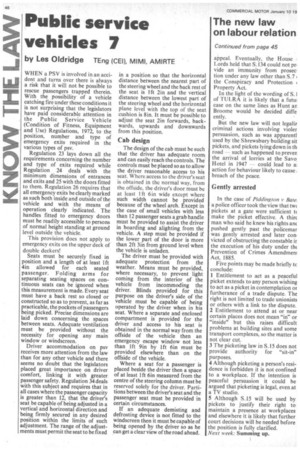Public service vehicles 7
Page 48

If you've noticed an error in this article please click here to report it so we can fix it.
by Les Oldridge TEng (CEO, MIMI, AMIRTE WHEN a PSV is involved in an accident and turns over there is always a risk that it will not be possible to rescue passengers trapped therein. With the possibility of a vehicle catching fire under these conditions it is not surprising that the legislators have paid considerable attention in the Public Service Vehicle (Condition of Fitness, Equipment and Use) Regulations, 1972, to the position, number and type of emergency exits required in the various types of psv.
Regulation 23 lays down all the requirements concerning the number and type of exits required while Regulation 24 deals with the minimum dimensions of entrances and exits and 25 with the doors fitted to them. Regulation 26 requires that all emergency exits be clearly marked as such both inside and outside of the vehicle and with the means of operation clearly indicated. The handles fitted to emergency doors must be readily accessible to persons of normal height standing at ground level outside the vehicle.
This provision does not apply to emergency exits on the upper deck of double deckers!
Seats must be securely fixed in position and a length of at least 1 ft 4in allowed for each seated passenger. Folding arms for separating seating spaces on continuous seats can be ignored when this measurement is made. Every seat must have a back rest so closed or constructed so as to prevent, as far as practicable, the pockets of passengers being picked. Precise dimensions are laid down concerning the spaces between seats. Adequate ventilation must be provided without the necessity for opening any main window or windscreen.
Driver accommodation on psv receives more attention from the law than for any other vehicle and there seems no doubt that the legislators placed great importance on driver comfort, linking it with greater passenger safety. Regulation 34 deals with this subject and requires that in all cases where the passenger capacity is greater than 12, that the driver's seat be capable of being adjusted in a vertical and horizontal direction and being firmly secured in any desired position within the limits of such adjustment. The range of the adjustments must permit the seat to be fixed in a position so that the horizontal distance between the nearest part of the steering wheel and the back rest of the seat is 1ft 2in and the vertical distance between the lowest part of the steering wheel and the horizontal plane level with the top of the seat cushion is 8in. It must be possible to adjust the seat 2in forwards, backwards, upwards and downwards from this position.
Cab design
The design of the cab must be such that the driver has adequate room. and can easily reach the controls. The controls must be placed so as to allow the driver reasonable access to his seat. Where access to the driver's seat is obtained in the normal way, from the offside, the driver's door must be at least 1 ft 6in wide except where such width cannot be provided because of the wheel arch. Except in the case of small vehicles with less than 12 passenger seats a grab handle must be provided to assist the driver in boarding and alighting from the vehicle. A step must be provided if the lower part of the door is more than 2ft 3in from ground level when the vehicle is unladen.
The driver must be provided with adequate protection from the weather. Means must be provided, where necessary, to prevent light coming from the interior of the vehicle from incommoding the driver. Blinds provided for this purpose on the driver's side of the vehicle must be capable of being operated by the driver when in his seat. Where a separate and enclosed compartment is provided for the driver and access to his seat is obtained in the normal way from the offside of the vehicle then an emergency escape window not less than 1ft 9in by 1ft 6in must be provided elsewhere than on the offside of the vehicle.
Where a seat for a passenger is placed beside the driver then a space of at least lft 6in measured from the centre of the steering column must be reserved solely for the driver. Partitions between the driver's seat and the passenger seat must be provided in certain circumstances.
If an adequate demisting and defrosting device is not fitted to the windscreen then it must be capable of being opened by the driver so as he can get a clear view of the road ahead.




































































































